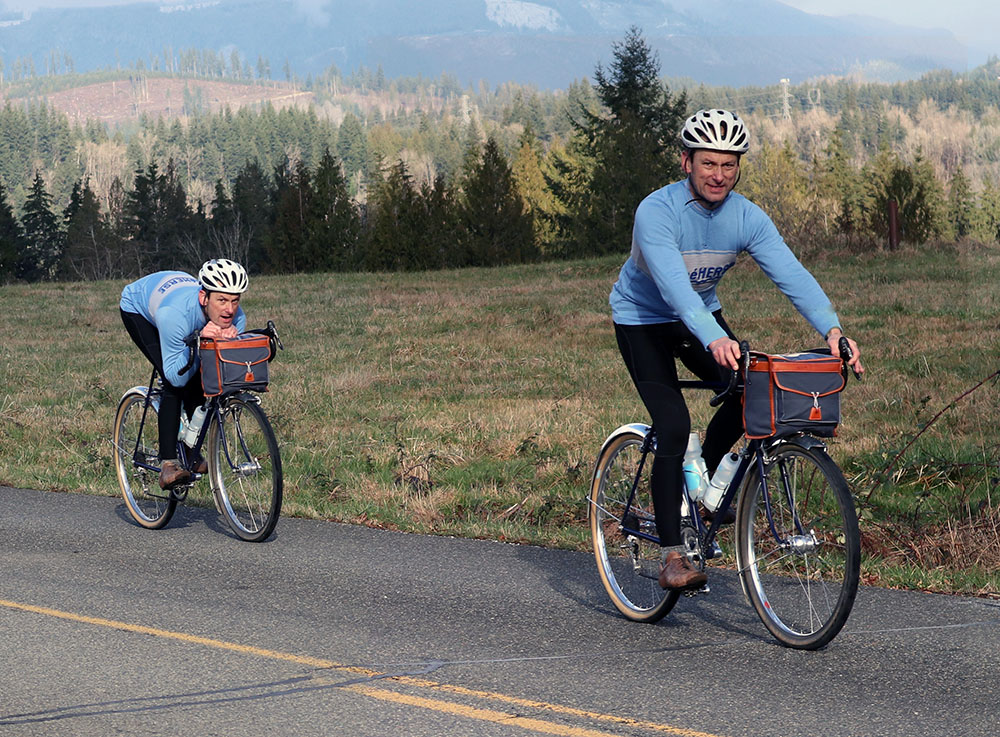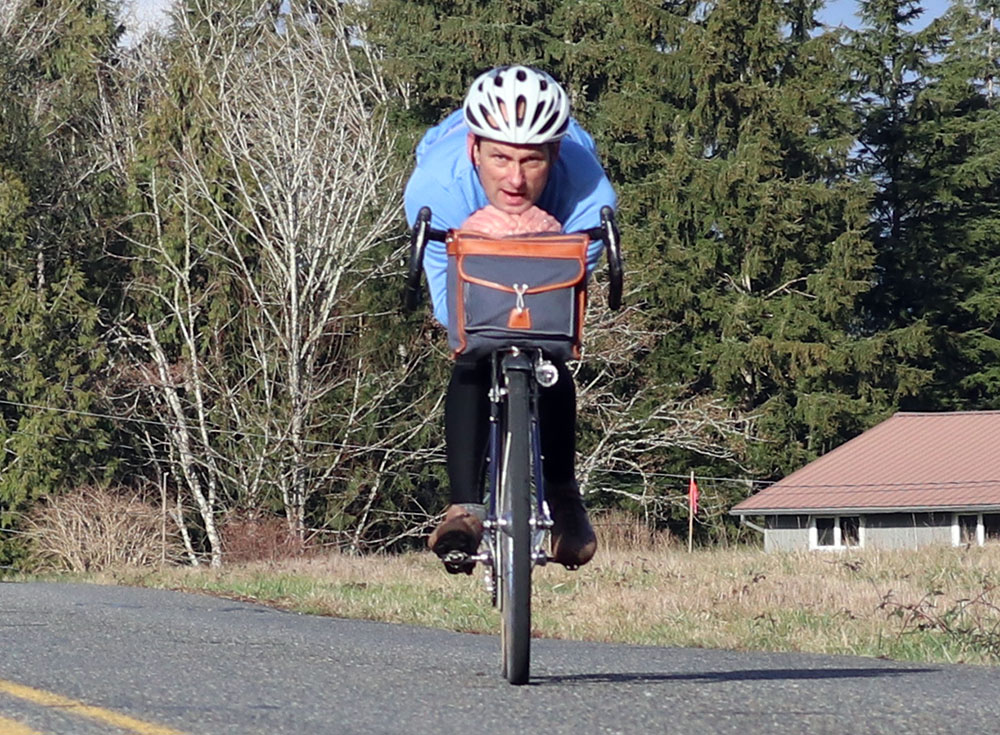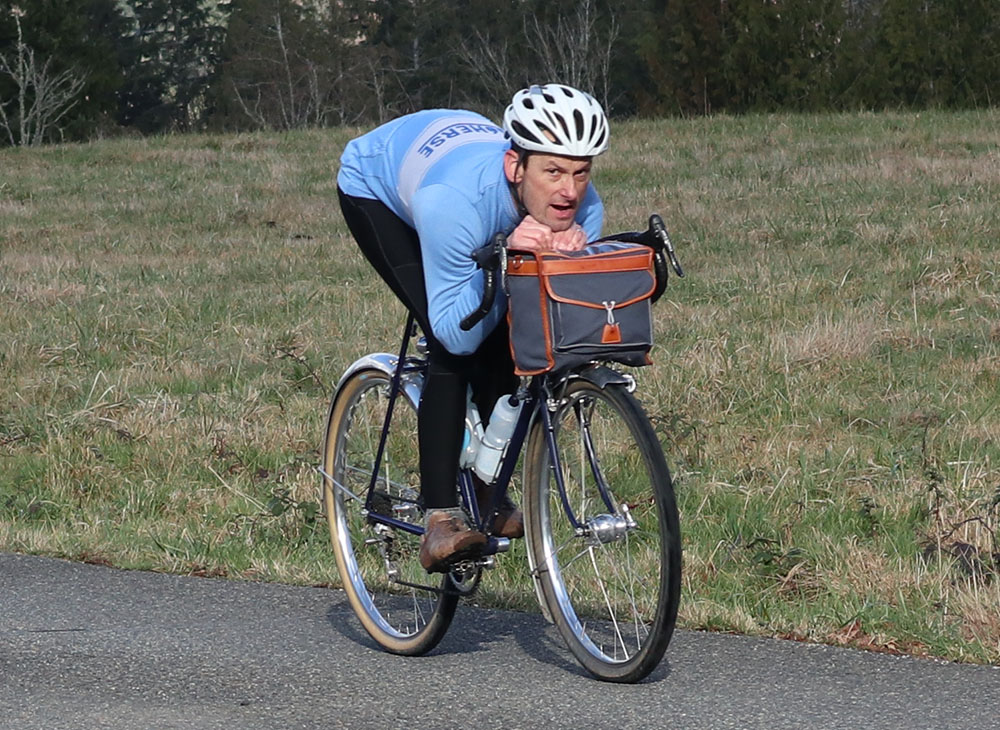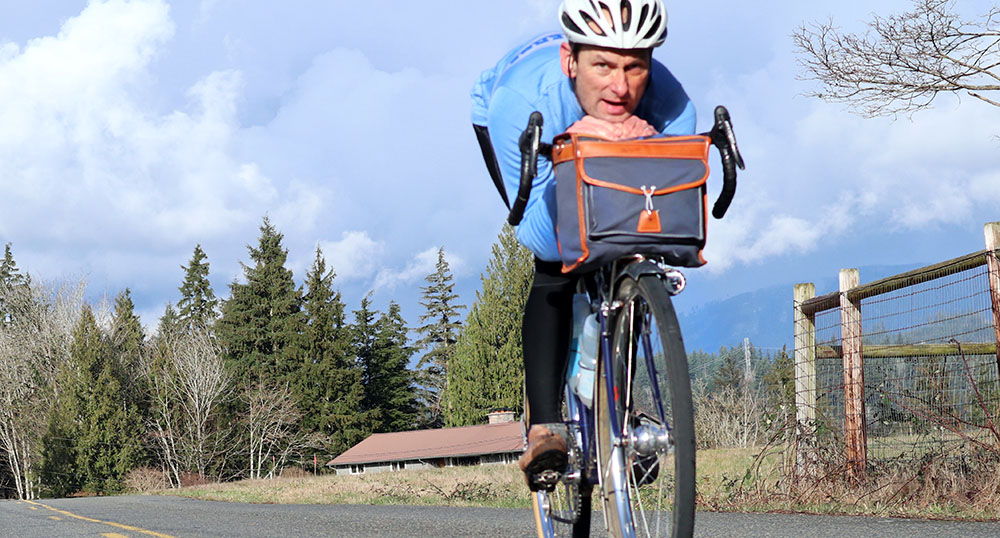Aerodynamics: Rando vs Racer
A few weeks ago, we talked about the difference between the soon-to-be-illegal ‘Super Tuck’ and the more stable ‘Aero Tuck.’ In that discussion, we touched upon the idea that a handlebar bag can act as a fairing and make the bike more aerodynamic.
For years, I’ve noticed that I coast at the same speed as some of the other riders on the Bicycle Quarterly Team when we’re in the aero tuck – if I’m on my randonneur bikes with handlebar bags. When I’m on a BQ test bike without a bag, I usually coast quite a bit slower. We use the same Rene Herse Extralight tires on our test bikes, and bearings and other ‘marginal’ resistances don’t really play a role at these high speeds – we’re talking 65+ km/h (40+ mph) – so the difference is all in the aerodynamics. Can a ‘boxy’ handlebar bag really act as a fairing and improve the rider’s aerodynamics (in the aero tuck).
To examine this idea, I looked at my Strava speeds on a course I ride from time to time. The ‘Mountain 100k’ has two long downhills where the bike reaches ‘terminal velocity’ – that means it no longer accelerates, but rolls at a steady speed. I descend those hills in the aero tuck, coasting. For aerodynamics, high-speed testing is useful, as all other resistances (bearings, etc.) don’t matter much compared to wind resistance. I rode the course on three different bikes, with and without handlebar bags. Before we go any further, I want to emphasize that all three are wonderful bikes, and it would be hard to pick one over the other for a spirited ride in the hills.
The four runs are comparable: My riding position on these three bikes is identical. Since I’m in the aero tuck, the width of the handlebars (wider on the MIN.D.) shouldn’t affect my speed, either. There was no significant wind on any of these days, and the two hills face in different directions, so if we see similar speed differences on both, then they aren’t caused by tailwinds. Here’s the data:
| Bike | Tire Width | Wheels | Handlebar Bag? | Lakemont Descent | Tiger Mtn. Descent |
| Rene Herse | 42 mm | Classic, generator hub | Yes | 58.6 mph | (44.5 mph)* |
| Firefly | 54 mm | Bladed Spokes | Yes | 58.6 mph | 47.2 mph |
| Firefly | 54 mm | Bladed Spokes | No | 53.5 mph | 44.1 mph |
| OPEN MIN.D. | 32 mm | Aero | No | 53.0 mph | 44.1 mph |
First of all, it came as a surprise that the racing bike, with its aero-shaped frame tubes, aero wheels and narrow tires, was actually the slowest on both hills. Looking at the data, the width of the tires doesn’t seem to have much of an effect on aerodynamics. Nor does the type of wheels (classic, bladed spokes or aero rims and bladed spokes). What seems to determine the downhill speed is whether the bike has a handlebar bag or not. In fact, the same bike (Firefly) with a bag was much faster than without.
The above suggests that, in the aero tuck, the handlebar bag makes the bike significantly faster. Both on Lakemont and on Tiger Mountain, a bike seems to roll 7-10% faster with a bag. You’ll notice the qualifiers ‘suggests’ and ‘seems.’ These runs were done on three different bikes, on four different days – and there are just four runs total. And Strava uses GPS to infer speed, and that’s not always reliable. So this is the start of a research project, not the end result. The next step is to use the same bike, do multiple runs on the same day (making sure that there is no wind), with and without a bag (equalizing the weight), and measure speed directly. Once we have a good set of data, we’ll have to do a statistical analysis to see whether the differences are real or just ‘noise’ in the data… and then we can say something with more certainty.
In the meantime, here are a few observations on why the aero tuck and and randonneur bikes appears to be so effective in improving aerodynamics.

If you need any convincing that it’s more efficient to tuck rather than pedal on steep downhills, the photo above should do the trick. My camera has a self-timer function which takes 10 shots in quick succession. I rolled past the camera, and copied two images into one.
I’m relatively upright in the front photo – I’d get in the drops and bend my elbows more when pedaling downhill – but even so, it’s easy to see how much smaller the frontal area is in the aero tuck. What’s also remarkable is how much bike, bag and body become one shape. My arms almost touch the bag, and my knees almost touch my elbows. That’s much more aero than pushing the bag, arms, chest and legs through the air separately, with turbulence surrounding each element. In cycling terms, my arms are drafting off the bag, my legs are drafting off my arms, and so on.

From the front, you can see how narrow the rider’s profile gets in the aero tuck – compare that to my 42 cm-wide handlebars! This is where the randonneur bike has an added advantage over the modern bikes: The top tube is level and sits higher, so my knees can touch each other below the top tube. That means they are about 50 mm (2″) closer together than on the MIN.D., where my knees touch the top tube on either side.
50 mm may not sound like much, but it’s actually quite significant. When we tested bikes in the wind tunnel, we found that lowering the stem by just 20 mm decreases wind resistance by 5%. Shoulders are wider than legs, but bringing the knees 50 mm inward will have a significant effect. (This is something we can test by putting a 50 mm-wide piece of foam between the legs and comparing the downhill speed.)
The Q factor on my rando bike is narrower, too – by about 10 mm – which puts my feet and legs closer together. Combined, getting the top tube out of the way and putting the feet closer together reduces the frontal area of the rider quite a bit – and our wind tunnel tests have shown that reducing the frontal area is the most effective way of improving a cyclist’s aerodynamics.

Getting the legs closer together not only reduces the frontal area, it also makes the rider shaped more like a teardrop: wide in front and narrow at the back. A teardrop is the ideal aerodynamic shape. This photo also shows how the bag helps achieve that teardrop shape. Without it, you have very un-aero gaps between arms, shoulders and legs. The bag is like a small fairing to complete the teardrop and close off those gaps.
We’ve long known that the rider’s aerodynamics are far more important than what you do to the bike. That’s why aerobars are so effective – but the aero tuck is even more aerodynamic. Of course, you can’t pedal when you’re tucked, but that’s OK, because the gains from improved aerodynamics increase exponentially the faster you go. On a hilly course, it’s not just the higher speed on the downhill, but how far you can roll on the flats (or up the next hill) before you need to start pedaling again. The aero tuck is the secret for moving fast with minimal effort on a hilly course. Over a long ride like Paris-Brest-Paris, the result is quite noticeable.
How about racing? While handlebar bags would probably count as fairing and thus be illegal in racing, getting legs and feet narrower is something that works on a racing bike, too. And during that long, lonely breakaway, it might just make the difference between winning or getting caught by the pack. And once we’ve got some real testing, we’ll know how big that difference really is!
Update 3/16/21: After posting this, I realize that there is potential for a misunderstanding. The fairing effect of the handlebar bag acts has been shown only in the aero tuck. When you look at the second photo with the rider in a more upright position, you see that the bag is much further from the rider’s body, so it’s ability to act as a fairing is reduced. Our wind tunnel testing showed that a bag or small fairing adds drag in that position, especially in a crosswind. For a record attempt with a support car, you wouldn’t use a handlebar bag. However, if you have to carry things, a handlebar bag is probably the best place – not just because it’s more aero when it matters the most (when you go ultra-fast on downhills). Mostly, handlebar bags make it easy to access your stuff without dismounting the bike. And since we’re going to carry a bag during long rides like Paris-Brest-Paris, we’ll optimize its aerodynamics as much as possible…
Further reading:
For a comprehensive overview about bike performance, check out our new book:
• The All-Road Bike Revolution: Make Your Bike Fast, Comfortable and Reliable



